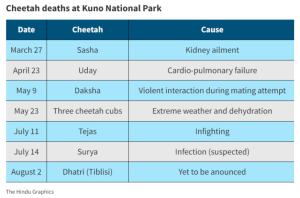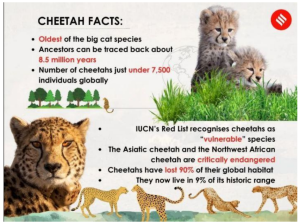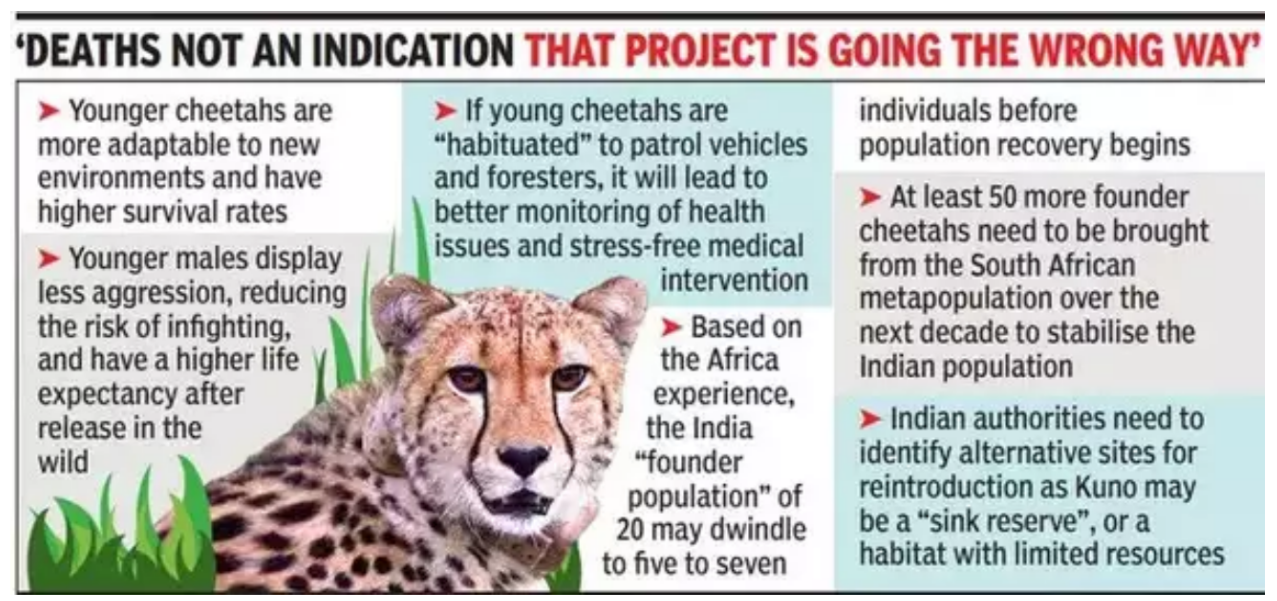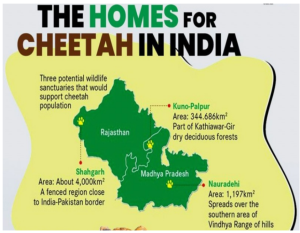Context: Recently, a female cheetah ‘Dhatri‘, brought under Project Cheetah to India, was found dead in Madhya Pradesh’s Kuno National Park.
More on News

- So far, nine cheetahs have died since March 2023, including three out of the four cubs that were born here.
- At present, 15 cheetahs remain — seven males, Seven females and a female cub.
About Project Cheetah
- Project Cheetah: The Government of India has launched it to bring back Cheetahs to India.
 Cheetahs were declared extinct in India in 1952.
Cheetahs were declared extinct in India in 1952.- To revive the population of Cheetah in India, the Indian government has made ambitious attempts to reintroduce the feline species.
- Implementing Body: National Tiger Conservation Authority (NTCA), a statutory body under Ministry of Environment.
- Objective: The Indian government hopes to bring 50 cheetahs from African countries to various national parks over the next five years.
- Currently, a total of 20 radio collared Cheetahs were brought from Namibia and South Africa to Kuno National Park, Madhya Pradesh, in a first ever transcontinental wild to wild translocation i.e Africa to Asia.
Reason for High Mortality of Cheetah at KNP:
- Untimely winter fur: The cheetahs were brought from the southern hemisphere where the winter solstice is in June.
- So the animals grew a thick winter coat as the monsoon peaked in India.
- This extra fur held more water and did not let the skin dry for extended periods.
- This ‘wet mat’ effect could weaken the skin over time and become vulnerable to pathogens attack.
- Collar Infections: Radio collars are suspected to have caused skin infections among some cheetahs leading to septicemia in two speculated deaths of Cheetahs.
- Septicemia is a blood poisoning by bacteria – which was a result of the radio collars worn around their necks in the prevailing wet conditions.
- Radio-collaring is a valuable tool in ecological research for tracking animal movements and behaviour to aid conservation efforts.
- Low immunity, novel pathogens: The pathogens that aggravated the wound under the collar could be novel either to the African cheetahs or to Indian conditions.
- These animals could be vulnerable to certain local pathogens.
- Or they could have carried some dormant pathogens that flourished in Kuno given the animals’ loss of immunity due to stress.
- Territorial Issues: Cheetahs are not known for strongly defending their territory like tigers or lions, however, male cheetahs are known for establishing small territories for themselves that overlap with the territories of several females leading to aggressive behaviour.
- A cheetah named Daksha was killed in a fight with other cheetahs inside the park in what could be a territorial fight between the animals.
- Adapting to Indian weather conditions: In southern Africa, cheetahs often give birth in late summer or early autumn and if the cubs are lost in the seasons, the replacement births are given in late winter or early spring.
- However, in India, female cheetahs are yet to adapt to opposite seasons in Asia and hence the mortality is expected to be high during initial years.
- Relative inexperience of the Indian veterinarians and monitoring teams: It was expected because very few vets or monitors in India have ever dealt with cheetahs before.
Other Concerns with Cheetah Relocation in india:
- Suitability of Kuno National Park (KNP): Cheetahs are known to excel in North Africa, the Sahel, and eastern and southern Africa and are known to ace survival in the open grasslands, savannahs of Namibia, dense vegetation, and mountainous terrain.
- However, KNP is a largely dry, deciduous forest land. Whereas the cheetahs from Africa are usually more adapted to the Savannahs of that continent.
- In 2023, management of KNP wrote to Union government to relocate some cheetahs out of KNP, as they “lack the manpower and infrastructure to support the felines in the wild”.
- Supreme Court also said that the Kuno National Park may not be sufficient to accommodate so many cheetahs.
- Fragmented Habitat: India’s grasslands are segmented by farmlands, rural habitation, and roads, particularly highways, leading to habitat fragmentation.
- Since the nucleus population of the reintroduced cheetahs is already small, being in a fragmented habitat would prevent healthy gene flow, increasing inbreeding, leading to a dangerously high prevalence of hereditary disorders and ailments.
- Disease risk: When animals are being introduced to a landscape, there is a risk of disease spread to both the individual animals that are being introduced and to the wildlife species which inhabit the site chosen for reintroduction (Kuno, in this case).
- According to International Union for Conservation of Nature (IUCN), “no translocated organisms can be entirely free of infection with micro-organisms or parasites, with consequent risk of their spread.”
- Human-Animal Conflict: Since their release in the open, the cheetahs have been seen to venture beyond the borders of the national park.
- Cheetah “Oban” entered the village on the outskirts of Kuno’s buffer zone and killed a cow in the village.
- Ecological Concerns: Lack of natural and probable prey and likely competition and conflict with the existent apex predator, the Indian leopard, and various opportunistic mesopredators might prove to be factors adversely affecting the sustainability of the population.
- Cheetahs being at the apex of the food chain, in most habitats reinserting them would cause the populations of their prey – medium-sized herbivores – to decline quickly, which might lead to an overgrowth of the latter’s diet, that is, grassland vegetation.
- In turn, as prey numbers do not recover quickly, ultimately the guest cheetahs could prove to be the cause of their own undoing.
- Loss of Grassland in India: India continues to lose its grasslands to desertification, agriculture, and construction activities.
- According to the United Nations Convention to Combat Desertification (UNCCD) Conference of Parties in India (2019), India lost a shocking 31% (about 56.500 square kilometers) of its grassland area in the 2005-2015 decade.
Previous Cheetah Relocation Programs
- South Africa: Nine of the first 10 reintroduction attempts in South Africa failed and it took more than 200 wild cheetahs during these initial reintroduction attempts to establish best practices with regards to wild cheetah introduction and management.
- Cheetah expert Vincent van der Merwe said that an estimation of loss of 50 per cent of the founder population in the first year post-release is standard for wild cheetah reintroductions in unfenced areas.
- Cub mortality will likely be high in the early years as most of the females will be first time mothers in India and are known to be bad at raising cubs.
- According to the NTCA, cheetahs, in general, have low survival rates, with only 50% of adult cheetahs surviving even in non-introduced populations.
- For introduced populations, the survival rates are even lower.

Way Forward
- More Translocation of Cheetah: According to the Cheetah Project Steering Committee, at least 50 founder cheetahs will be required before the Indian population stabilises.
- Further swaps between the Southern African and Indian metapopulations will be required to ensure genetic and demographic viability in the long term.
- Cheetah Project Steering Committee was constituted by NTCA to review the progress of the reintroduction project and monitor and advise on it.
- Providing Open Grassland Area: Cheetahs inhabit open grasslands and scrublands, with breeding males being highly territorial, often claiming and defending about 40-80 square kilometers of territory each.
- It is vital to ensure that open, unfragmented grassland habitats be made available to the cheetah populace for them to thrive.

- Other Site for Reintroduction: The experts recommended having at least two additional reintroduction sites available by the end of 2024, with an area of above 50 square kilometers and preferably fenced as unfenced systems worldwide have not seen successful cheetah reintroduction.
- NTCA said it is preparing Gandhi Sagar Wildlife Sanctuary and Nauradehi Wildlife Sanctuary in Madhya Pradesh as an alternative.
- Health Monitoring: India needs thorough disease screening processes and protocols for managing threats from infections as part of the cheetah reintroduction plans.
- Other Steps: Cheetahs need to be fitted with lighter collars with a softer belt material.
- There needs to be better monitoring of the animals with on-field observations.
- Cheetah adapting on an “evolutionary timescale” might be the only permanent solution to the winter coats.
Conclusion
- It will still take a few years to gauge the success or failure of the project once cheetahs establish their home range in the Indian ecosystem.
- For the project to be a success, patience and time are the essential elements before any conclusions are drawn.
News Source: Indian Express
![]() 14 Aug 2023
14 Aug 2023

 Cheetahs were declared extinct in India in 1952.
Cheetahs were declared extinct in India in 1952.

